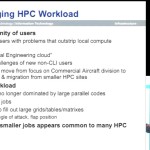With a broader user community making use of HPC computing, there are significant changes in the work mix of jobs being processed by HPC systems. A move away from large parallel applications toward a wider variety of smaller and shorter running applications put new and different strains on both PBS and the system overall. To address these workloads, we have begun to deploy new strategies, including a hook to limit job initiation rates, as well as working with our users to address their needs to run thousands or millions of independent cases.
European Strategy for HPC and Exascale
In February 2012 the European Commission (EC) published a Communication highlighting the strategic nature of High Performance Computing (HPC) as a crucial asset for the European Union’s (EU’s) innovation capacity, proposing a series of activities that could lead to European leadership in both the supply and the use of HPC systems and services by 2020.
The Communication views HPC as an important tool in addressing societal and scientific grand challenges, and in helping industry to be more innovative and competitive. It notes that while Europe buys 32% of the world’s HPC systems, it only provides 4.3% of these systems. European HPC capacity decreased by 10% from 2008 to 2010, while the US and Japan each have more HPC capacity than all European countries combined, and both China and Russia have declared HPC an area of strategic priority funded by significant investment. The EU has significant strengths in the areas of scientific and engineering software, as well as parallel software development.
In 1975 Europe set up the European Space Agency as it saw independent access to space as being a strategic goal for Europe. The Commission advocates a similar strategic decision for HPC systems and services.




